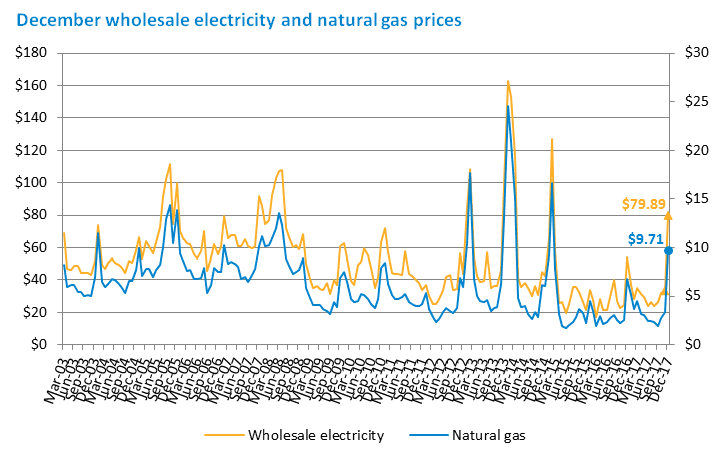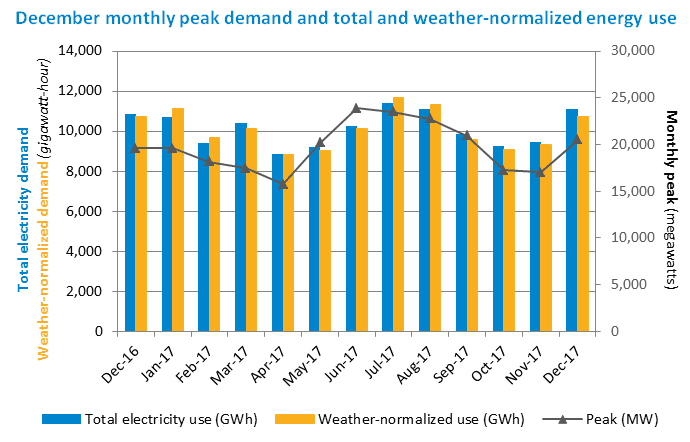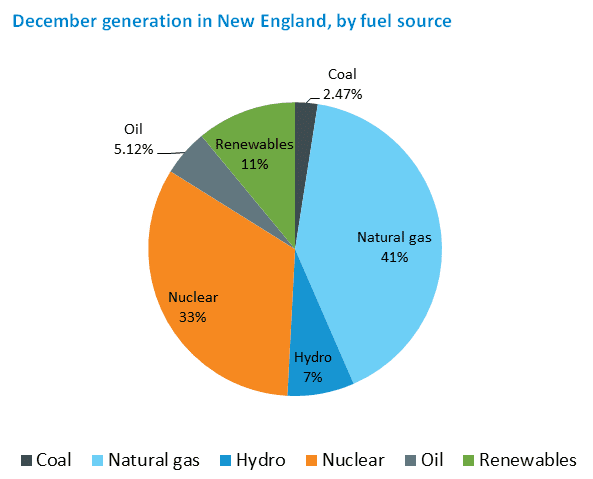Monthly wholesale electricity prices and demand in New England, December 2017
 Energy market transactions in December totaled $856 million, with nearly half incurred in the last week
Energy market transactions in December totaled $856 million, with nearly half incurred in the last week
Extreme cold weather at the end of December caused the average price of natural gas to rise more than 40% for the month, pushing the price of wholesale power up nearly 50% higher than the wholesale power price in December 2016. A cold snap that began December 26 pushed up demand for both natural gas and electricity, raising prices and resulting in a total energy market value of $856 million for the month. The bulk of that energy market value came in the last week of the month, during the cold snap, when the energy market value was $395.6 million for just one week.
The late-month surge in natural gas prices drove the monthly average price for wholesale electricity up by 48% in December, to $79.89 per megawatt-hour (MWh)* compared to the December 2016 price of $53.83/MWh. The December wholesale power price was more than double the November price of $33.30/MWh.
The month was also marked by a price inversion that tends to occur during extreme cold weather, when the demand for natural gas for both heating and power generation rises, causing natural gas prices to rise as well. During much of the cold snap, the price of oil was lower than the price of natural gas and, as a result, dual-fuel generators running on oil and oil-fired power plants that typically don’t run very often were dispatched more frequently than generators using natural gas. The level of power generated by oil in New England rose from just under 1% in December 2016 and 0.2% in November 2017 to over 5% in December 2017.
Drivers of Wholesale Electricity Prices
In general, the two main drivers of wholesale electricity prices in New England are the cost of fuel used to produce electricity and consumer demand.
Power Plant Fuel: Fuel is typically one of the major input costs in producing electricity. Natural gas is the predominant fuel in New England, used to generate 49% of the power produced in the region last year, and natural gas-fired power plants usually set the price of wholesale electricity in the region. As a result, average wholesale electricity prices are closely linked to natural gas prices.
The average natural gas price during December was $9.71 per million British thermal units (MMBtu)**, up 43.8% from the December 2016 average Massachusetts natural gas index price of $6.75/MMBtu. The Mass. index price is a volume-weighted average of trades at four natural gas delivery points in Massachusetts, including two Algonquin points, the Tennessee Gas Pipeline, and the Dracut Interconnect. The December average natural gas price was up 185.2% from the previous month’s price of $3.40/MMBtu.
Electricity Demand: Demand is driven primarily by weather as well as economic factors. Energy usage during December 2017 rose 1.8% to 11,082 gigawatt-hours (GWh) from the 10,884 GWh used in December 2016. The average temperature during December was 28˚ Fahrenheit (F) in New England, down from the 32˚ average temperature recorded during the previous December. The average dewpoint, a measure of humidity, was 17˚F, compared to 21˚F in December 2016. The number of heating degree days (HDD)*** came in at 1,161 in December, compared to 1,012 HDD in December 2016. The normal December level is 982 HDD in New England. There were no cooling degree days in December.
Peak demand for the month was recorded at 20,476 MW on December 28 during the hour from 5 to 6 p.m., when the temperature in New England was 8°F and the dewpoint was -10°. The December 2017 peak was 4.2% higher than the December 2016 peak of 19,647 MW, set during the hour from 5 to 6 p.m. on December 15, 2016, when the temperature was 18°F and the dewpoint was -9°.
Peak demand is driven by weather, which drives the use of heating and air conditioning equipment. The all-time high winter peak was 22,818 MW, recorded during a cold snap in January 2004 when the temperature was -1°F and the dewpoint was -20°. The all-time peak demand in New England was 28,130 MW, recorded during an August 2006 heat wave, when the temperature was 94°F and the dewpoint was 74°. Air conditioning use is far more widespread than electric heating in New England, so weather tends to have a relatively greater impact on the summer peak than the winter peak.
Fuel Mix: The mix of resources used in any given time period depends on price and availability, as well as supplemental resource commitments needed to ensure system stability. Natural gas-fired and nuclear generation produced 74% of the 9,060 gigawatt-hours (GWh) of electric energy generated within New England during November, at about 41% and 33%, respectively. Renewable resources generated about 11% of the energy produced within New England, including 7% from wood, refuse, and landfill gas; 4% from wind; and 0.3% from solar resources. Coal units generated 2.5%, and oil-fired resources produced 5.1% of the energy generated within New England. Hydroelectric resources in New England generated 7%. The region also received net imports of about 2,182 GWh of electricity from neighboring regions.
| December 2017 and Percent Change from December 2016 and November 2017 |
December 2017 | Change from December 2016 | Change from November 2017 |
|---|---|---|---|
| Average Real-Time Electricity Price ($/megawatt-hour*) |
$79.89 | +48.4% | +139.9% |
| Average Natural Gas Price ($/MMBtu**) |
$9.71 | +43.8% | +185.2% |
| Peak Demand | 20,476 MW | +4.2% | +20.4% |
| Total Electricity Use | 11,082 GWh | +1.8% | +17.3% |
| Weather-Normalized Use**** | 10,721 GWh | -0.1% | +15.2% |
*One megawatt (MW) of electricity can serve about 1,000 average homes in New England. A megawatt-hour (MWh) of electricity can serve about 1,000 homes for one hour. One gigawatt-hour (GWh) can serve about 1 million homes for one hour. **A British thermal unit (Btu) is used to describe the heat value of fuels, providing a uniform standard for comparing different fuels. One million British thermal units are shown as MMBtu. ***A degree day is a measure of heating or cooling. A zero degree day occurs when no heating or cooling is required; as temperatures drop, more heating days are recorded; when temperatures rise, more cooling days are recorded. The base point for measuring degree days is 65 degrees; each degree of a day’s mean temperature that is below 65 degrees is counted as one heating degree day. A day’s mean temperature of 45 degrees equals 20 heating degree days. ****Weather-normalized demand indicates how much electricity would have been consumed if the weather had been the same as the average weather over the last 20 years.




- Categories
- Inside ISO New England
- Tags
- monthly prices, wholesale prices
